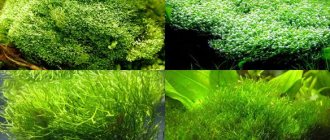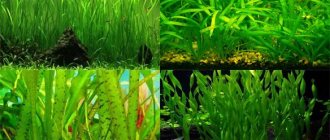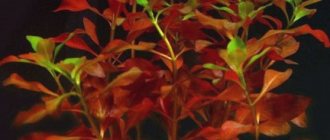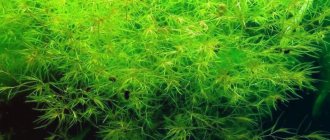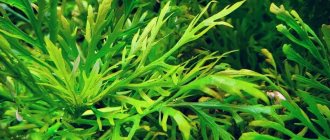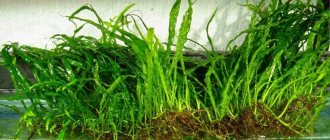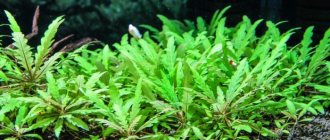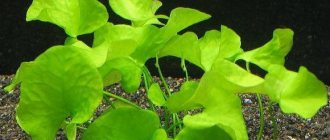Bacopa is a perennial plant from the Norichaceae family, found naturally in swampy areas and flooded banks of water bodies in Africa, America and Northern India. The bacopa plant also has another name, “sutera,” which refers to varieties that grow on land. The plant grows well in tropical and subtropical environments, there are about 100 species of bacopa, mostly aquatic, so its cultivation often takes place in an aquarium. The most famous species are Bacopa Carolinas, Bacopa Monnieri, Bacopa Madagascar, Japanese and Australian.
Caroline
Description
Bacopa carolina is widespread in the Atlantic coast of Central and South America. The plant is a long stem with oval green leaves, reaching up to 2.5 cm in size and located in pairs on the stem. In nutritious soil and in intense light, bacopa grows beautifully. The Carolina variety has a delicate blue flower.
Australian bacopa is common in the waters of Brazil and grows near the shores of lakes and streams. Among other types of bacopa, the Australian variety is considered the smallest, but with a more developed root system. Its leaves are bright green with a pinkish tint and reach a width of 2-4 cm, located opposite each other. This bacopa grows up to 40 cm in height.
Bacopa Madagascar is native to the island of Madagascar and grows in streams and small ponds. This species is extremely useful in the aquarium, as Bacopa Madagascar is able to perfectly purify water and prevent the growth of algae. Aquarium Bacopa Madagascar has a thick stem 4 mm thick with erect or creeping shoots. The leaves are light green, oppositely cross-shaped, covering almost the entire stem. The shape of the leaves is lanceolate or narrowly ovate, up to 3 cm in length and up to 1.5 cm in width. Bacopa Madagascar reaches a height of up to 15 cm, blooms with purple flowers.
Bacopa monnieri or moniera is a beautiful plant with an erect or creeping stem reaching 40 cm in length. This unpretentious plant has bare leaves, caring for it is not difficult; growth slows down in case of extreme discomfort in its habitat. This small-leaved bacopa has small, white or pink flowers.
Return to content
Australian
Price
Depending on the variety, Carolina bacopa costs from 40 to 230 rubles per sprig. The plant with green leaves is the cheapest. Cultivated shrubs with purple flowers will cost the buyer more than 200 rubles.
Bacopa Carolinas is an unpretentious plant. It not only decorates the tank, but also benefits the aquarium inhabitants. The variety of varieties allows you to choose a flower that matches your design solution. And their ease of care makes it possible to use them for cultivation not only by experienced aquarists, but also by novice hobbyists.
If you liked the article, leave comments and share a link to it on social networks.
Keeping in an aquarium
Bacopa is an unpretentious plant that can be kept in tropical and moderately warm aquariums. But given the swampy nature of bacopa, the most effective cultivation of this plant will be in a paludarium or in a wet greenhouse. The optimal temperature regime is considered to be 22-28°C, and at lower temperatures, growth slows down and the leaves of the plant begin to rot. Carolina Bacopa grows well in soft, slightly acidic water. Leaf deformation occurs at high hardness, so it is recommended to keep it at a dH of 6-8°.
Bacopa does not respond to the accumulation of organic elements in the aquarium, which could inhibit its growth. Its leaves are resistant to sedimentation of mineral particles and fouling. The Monnier species is suitable for brackish water environments and can withstand even hard, alkaline water. The acidity can be 6.5 -7.5, and water changes should be made once every two weeks with a fourth or fifth of the volume of water.
It is recommended to lay out small pebbles or sand in a layer of 2-4 cm as a soil substrate. All plant varieties have a weak root system; they receive most of their nutrients mainly from water. It is allowed for the soil in the aquarium to be moderately silted. Aquarium bacopa does not need additional feeding, since it has enough nutrients obtained from fresh water and fish food.
Return to content
Madagascar
Aquadesign
Long-stemmed species of Bacopa aquarium are usually placed near the back wall of the aquarium. This foliage plant can be used to create a very beautiful, bright green, dense background. The plant is usually planted in the ground in groups, although low-growing species of this algae also look very beautiful in single plantings, for example, next to large shells or near driftwood. The unusual shape of the leaves allows you to create a bright, interesting element against the background of other plants.
This plant can be cut, and thanks to this you can create very interesting shapes of bushes. When pruned, bacopa begins to grow in breadth, producing many side shoots. Bacopa can be used to create beautiful spherical bushes in the middle of the aquarium in the foreground. A few trimming cycles and you will have a very lush bush with small green leaves.
Lighting
High-quality care for bacopa provides one important condition for life in an aquarium, which applies to all its species. Growing bacopa requires a sufficient amount of lighting, since the plant does not feel well if there is not enough light. Natural diffused sunlight is very beneficial for the plant, and incandescent and fluorescent lamps can be used for artificial lighting. It is advisable that daylight hours last for at least 11 hours.
Return to content
Diseases and pests
Most diseases occur when planting and care rules are violated; to avoid this, it is necessary to follow the schedules of watering, winter dormancy and fertilization. A weakened plant may be susceptible to infection by fungal diseases or attack by pests.
Common diseases and pests:
- gray rot;
- sooty fungus;
- root rot;
- aphid;
- spider mite;
- whitefly
When the first signs of the disease are detected, it is necessary to remove the damaged parts of the plant and treat with insecticides or fungicides. In some cases, an infected bush is dug up and burned to prevent the spread of the disease.
Correct placement
It is best to place the plant in the aquarium in a separate pot and place it on a side shelf near a natural light source or lamp. Bacopa monnieri looks good in the corners of the aquarium, as this plant grows rapidly and occupies the entire corner area. Growing the plant horizontally can be achieved by pressing it down with a rock, after which it will take root properly and resemble a thin green mat. A very beautiful combination can be achieved by planting different types of bacopa at different levels, placing them around the perimeter of the aquarium.
Return to content
Beneficial properties of bacopa extract
Bacopa flower is popular in Ayurvedic medicine. It is used to make food supplements that improve mental performance, reduce anxiety, and improve memory. All this is achieved by stimulating and strengthening brain and nerve cells.
Also, products with bacopa extract are used as anti-aging drugs, strengthening the immune system and prolonging life, treating depression and headaches. Bacopa as part of dietary supplements can strengthen the adrenal glands and help fight the effects of stress, stroke, and traumatic brain injuries.
There are contraindications, as well as a number of side effects. Consultation with a doctor is necessary, as self-medication can be harmful to health.
Reproduction
Carolina bacopa propagates vegetatively by stem cuttings; its apical shoots are planted in the ground after they reach 10-15 cm in length. In this case, there is no need to deepen the lower whorl of leaves too much. After a certain time after this process, roots will appear at the base of the plant leaves. In the Australian species, the lateral shoots of at least 5 cm are cut off and planted in a new location. If roots do not appear on a young plant, you can leave it floating in water until its roots grow. Reproduction of all other types of bacopa also occurs vegetatively.
Return to content
Monier
If you want to buy bacopa flower
Aquatic species of bacopa do not look very impressive individually, so they are sold and planted ten at a time. The price of such a bouquet of stems is on average 450 rubles. One stalk of a rare, unusual species can cost 200 rubles.
Before you buy bacopa in a pot, inspect it carefully. Stems and leaves must be strong and clean, free from damage and pests.
Even if you are sure that the plant is free from parasites, it is still better to give the newly acquired plant a warm shower immediately after purchase. This will at least refresh it, and can also wash away insects that have hidden from your view.
You can transplant bacopa into its designated pot or aquarium immediately after purchase. After this, let it sit in the shade for several days. The plant should be severely pruned so that it does not bloom during the period of adaptation to the new place and retains the strength for successful rooting. In addition, this stimulates the bush to further vigorous branching.
Care
Proper care of bacopa should consist of regular thinning of its thickets and timely pruning of excess overgrowth. This will help maintain decorativeness and encourage the plant to form young shoots. By feeding the soil with minerals, the plant will develop and bloom better.
Bacopa is one of the unpretentious aquarium plants that is easy to propagate and does not require any effort from the owner. Growing it in aquarium conditions will not cause much trouble, if you take into account some features in the maintenance of bacopa. Conscientious care of this plant will ensure its growth throughout the year, delighting with the beautiful blooming of delicate flowers.
Return to content
About the species, history, habitat
Carolina Bacopa is a popular aquarium plant that belongs to the Norichinaceae family, the genus Bacopa. If you provide quality care, the plant begins to spread along the bottom, thereby creating shelter for the aquarium inhabitants and the future fry. Bacopa grows in fresh and salty waters.
Bacopa is a plant native to the Atlantic coast of America. The aquarium plant has long stems and oval leaf blades. If high-quality lighting is installed and it is long-lasting, the leaves may acquire a brown, bronze, or rarely pink tint. Sometimes the plant is partially immersed in water. There are times when bushes, during the process of growth, peek out of the water on their own, since the height of the aquarium is insufficient. In this case, the room will be filled with a subtle aroma of lemon.
Carolina Bacopa is excellent for growing in paludariums. The advantage of this variety is its high level of resistance to diseases and the appearance of plaque and fouling. Bacopa is also attractive because it can bloom all year round. The flowers are painted in a delicate purple hue, there are 5 petals in total.
